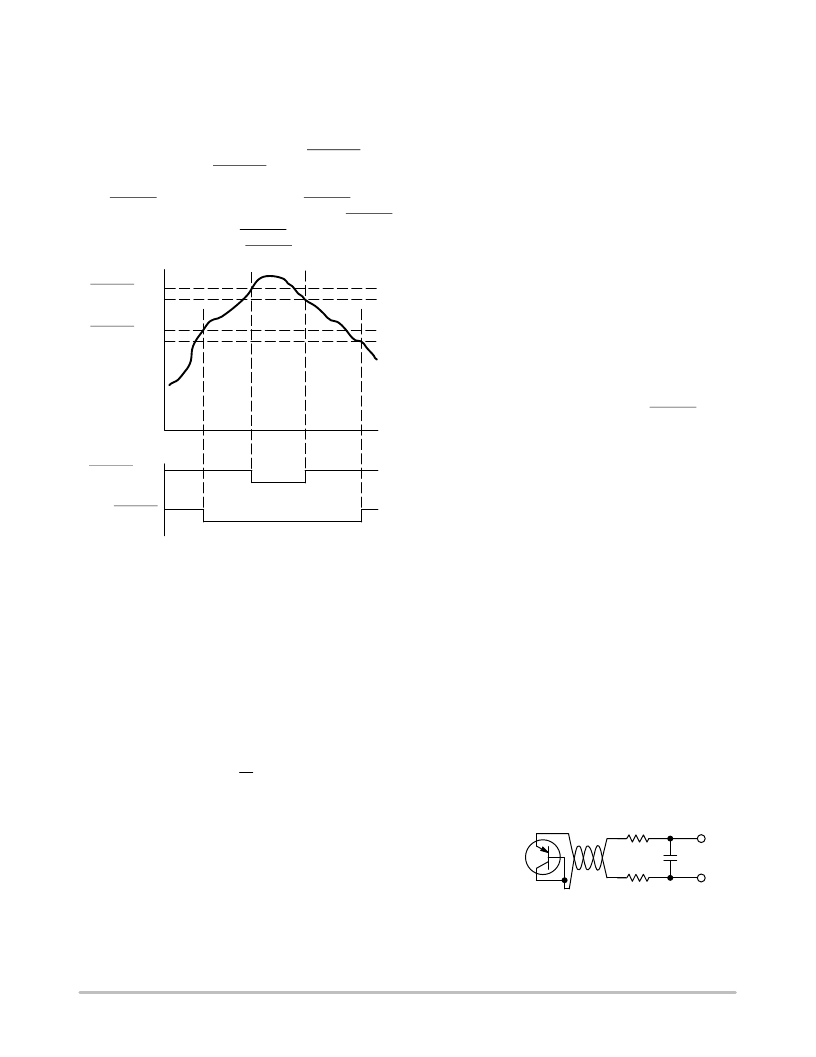- 您现在的位置:买卖IC网 > Sheet目录482 > NCT65DMR2G (ON Semiconductor)IC TEMP MON TRIP POINT 8-MSOP
�� �
�
NCT65�
�REMOTE�
�100� W�
�Theory� of� Operation�
�The� NCT65� is� a� remote� trip� point� temperature� sensor� for�
�use� in� a� vide� variety� of� applications� from� smart� phones� to�
�embedded� systems.� The� remote� temperature� is� measured� by�
�the� NCT65� and� then� compared� with� a� fixed� limit� set� by� the�
�internal� device� reference.� The� limit� for� the� THERM1� pin� is�
�70� ?� C� and� the� limit� for� the� THERM2� pin� is� 85� ?� C.� If� either� the�
�remote� temperature� exceeds� the� defined� limits� the� open�
�drain� THERM� pins� are� asserted� low.� Each� THERM� pin� self�
�clears� when� the� temperature� drops� 5� ?� C� below� the� THERM�
�limit.� This� is� to� prevent� THERM� jitter,� where� the�
�temperature� hovers� around� the� THERM� limit.�
�THERM2� =� 85�
�Hyst� =� 5�
�THERM1� =� 70�
�Hyst� =� 5�
�Time�
�THERM2�
�THERM1�
�Figure� 2.� Trippoints�
�Measurement� Method�
�A� simple� method� of� measuring� temperature� is� to� exploit�
�the� negative� temperature� coefficient� of� a� diode,� or� the�
�base-emitter� voltage� of� a� transistor,� operated� at� constant�
�current.� Unfortunately,� this� technique� requires� calibration� to�
�null� out� the� effect� of� the� absolute� value� of� V� BE� ,� which� varies�
�from� device� to� device.�
�The� technique� used� in� the� NCT65� is� to� measure� the� change�
�in� V� BE� when� the� device� is� operated� at� three� different�
�currents.�
�This� is� given� by:�
�q�
�D� V� BE� +� (n� f� )� kT� In(N)� (eq.� 1)�
�Where:�
�k� is� Boltzmann’s� constant� (1.38� ?� 10� –23� ).�
�q� is� the� charge� on� the� electron� (1.6� ?� 10� –19� Coulombs).�
�T� is� the� absolute� temperature� in� Kelvins.�
�N� is� the� ratio� of� the� two� currents.�
�n� f� is� the� ideality� factor� of� the� thermal� diode.�
�The� NCT65� is� trimmed� for� an� ideality� factor� of� 1.008.�
�To� prevent� ground� noise� interfering� with� the�
�measurement,� the� more� negative� terminal� of� the� sensor� is� not�
�referenced� to� ground� but� is� biased� above� ground� by� an�
�internal� diode� at� the� D� ?� input.� If� the� sensor� is� operating� in� a�
�noisy� environment� an� optional� filter� can� be� added.� Its� value�
�should� be� no� more� than� 1,000� pF.� See� the� Layout�
�Considerations� section� for� more� information� on� C1.�
�To� measure� D� V� BE� ,� the� operating� current� through� the�
�sensor� is� switched� among� three� related� currents.�
�N1� ?� I� and� N2� ?� I� are� different� multiples� of� the� current,� I.�
�The� currents� through� the� temperature� diode� are� switched�
�between� I� and� N1� ?� I,� giving� D� V� BE1� ;� and� then� between� I� and�
�N2� ?� I,� giving� D� V� BE2� .� The� temperature� is� then� calculated�
�using� the� two� D� V� BE� measurements.� This� method� also�
�cancels� the� effect� of� any� series� resistance� on� the� temperature�
�measurement.� The� resulting� waveform� is� passed� through� a�
�65� kHz� low-pass� filter� to� remove� noise,� and� then� to� a�
�chopper-stabilized� amplifier� that� performs� the� functions� of�
�amplification� and� rectification� of� the� waveform� to� produce�
�a� dc� voltage� proportional� to� D� V� BE� .� This� voltage� is� input� into�
�two� comparators� with� a� reference� voltage.� If� the� voltage�
�exceeds� the� reference� voltage� then� the� THERM� output�
�asserts� low.�
�Applications� Information�
�Noise� Filtering�
�For� temperature� sensors� operating� in� noisy� environments,�
�the� industry� standard� practice� was� to� place� a� capacitor� across�
�the� D+� and� D� ?� pins� to� help� combat� the� effects� of� noise.�
�However,� large� capacitances� affect� the� accuracy� of� the�
�temperature� measurement,� leading� to� a� recommended�
�maximum� capacitor� value� of� 1,000� pF.� Although� this�
�capacitor� reduces� the� noise,� it� does� not� eliminate� it,� making�
�it� difficult� to� use� the� sensor� in� a� very� noisy� environment.�
�The� NCT65� has� a� major� advantage� over� other� devices�
�when� it� comes� to� eliminating� the� effects� of� noise� on� the�
�external� sensor.� The� series� resistance� cancellation� feature�
�allows� a� filter� to� be� constructed� between� the� external�
�temperature� sensor� and� the� part.� The� effect� of� any� filter�
�resistance� seen� in� series� with� the� remote� sensor� is�
�automatically� cancelled� from� the� temperature� result.�
�The� construction� of� a� filter� allows� the� NCT65� and� the�
�remote� temperature� sensor� to� operate� in� noisy� environments.�
�The� figure� below� shows� a� low-pass� R-C-R� filter,� where�
�R� =� 100� W� and� C� =� 1� nF.� This� filtering� reduces� both�
�common-mode� and� differential� noise.�
�100� W�
�D+�
�TEMPERATURE� 1� nF�
�SENSOR�
�D� ?�
�Figure� 3.� Filter� between� Remote� Sensor� and� Factors�
�Affecting� Diode� Accuracy�
�http://onsemi.com�
�4�
�发布紧急采购,3分钟左右您将得到回复。
相关PDF资料
NCV8440STT1G
MOSFET N CH 2.6A 59V SOT-223-4
NDB5060L
MOSFET N-CH 60V 26A D2PAK
NDB6060
MOSFET N-CH 60V 48A TO-263AB
NDB7060
MOSFET N-CH 60V 75A D2PAK
NDC7001C
MOSFET N+P 60V 340MA SSOT6
NDC7002N_SB9G007
MOSFET N-CH DUAL 50V 6-SSOT
NDC7003P
MOSFET 2P-CH 60V 340MA SSOT6
NDD03N50ZT4G
MOSFET N-CH 500V 2.6A DPAK
相关代理商/技术参数
NCT6627UD
制造商:Nuvoton Technology Corp 功能描述:IC LPC SUPER I/O 128LQFP
NCT675
制造商:New Concept Tools 功能描述:TOOLS, DRILL BITS; Kit Contents:31 Pieces of 5 Straight, 4 Phillips, 4 Pozidrive, 10 Hex, & 10 Torx Bits ;RoHS Compliant: NA
NCT6776D
制造商:Nuvoton Technology Corp 功能描述:IC LPC SUPER I/O 128LQFP
NCT6776F
制造商:Nuvoton Technology Corp 功能描述:LPC SUPER I/O, PECI 3.0, SST*, 制造商:Nuvoton Technology 功能描述:LPC SUPER I/O, PECI 3.0, SST*,
NCT6779D
制造商:Nuvoton Technology Corp 功能描述:NEW 128-PIN SIO, BASICALLY PIN
NCT72CMNR2G
功能描述:板上安装温度传感器 REMOTE THERMAL SENSOR RoHS:否 制造商:Omron Electronics 输出类型:Digital 配置: 准确性:+/- 1.5 C, +/- 3 C 温度阈值: 数字输出 - 总线接口:2-Wire, I2C, SMBus 电源电压-最大:5.5 V 电源电压-最小:4.5 V 最大工作温度:+ 50 C 最小工作温度:0 C 关闭: 安装风格: 封装 / 箱体: 设备功能:Temperature and Humidity Sensor
NCT72CMTR2G
功能描述:板上安装温度传感器 REMOTE THERMAL SENSOR RoHS:否 制造商:Omron Electronics 输出类型:Digital 配置: 准确性:+/- 1.5 C, +/- 3 C 温度阈值: 数字输出 - 总线接口:2-Wire, I2C, SMBus 电源电压-最大:5.5 V 电源电压-最小:4.5 V 最大工作温度:+ 50 C 最小工作温度:0 C 关闭: 安装风格: 封装 / 箱体: 设备功能:Temperature and Humidity Sensor
NCT72DMNR2G
功能描述:板上安装温度传感器 DIGTEMPSEN2WIREINTF RoHS:否 制造商:Omron Electronics 输出类型:Digital 配置: 准确性:+/- 1.5 C, +/- 3 C 温度阈值: 数字输出 - 总线接口:2-Wire, I2C, SMBus 电源电压-最大:5.5 V 电源电压-最小:4.5 V 最大工作温度:+ 50 C 最小工作温度:0 C 关闭: 安装风格: 封装 / 箱体: 设备功能:Temperature and Humidity Sensor